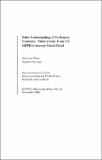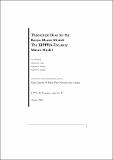Discussion Paper No. 02 of 2000 on Macro Models of the Kenya Economy: a Review
| dc.date.accessioned | 2021-03-29T07:02:10Z | |
| dc.date.available | 2021-03-29T07:02:10Z | |
| dc.date.issued | 2000 | |
| dc.identifier.uri | http://repository.kippra.or.ke/handle/123456789/2749 | |
| dc.description.abstract | This paper critically reviews the existing Kenyan macroeconomic models, identifying their strengths and weaknesses. It argues that there are major weaknesses in the two existing models, MEPM and MELT3, particularly their failure to recognize the importance of the supply-side factors in the economy. The rudimentary treatment given to the supply-side by the two models inevitably means that forecasts generated by the models downplay the significance of stmctural rigidities in the economy in determining the final outcome of policy measures. The paper also reviews two key models, used by the World Bank and the International Monetary Fund, for analysing the economies of developing countries including Kenya. Like the existing Kenyan models, the World Bank and the IMF models are also useful for short-term policy analysis, but their use for medium-to long-term forecasting is limited as they are weak in representing production in the real sector. The paper therefore justifies the case far a new macro model of the Kenyan economy. It discusses the key macroeconomic sectors that should go into the new model and provides initial thoughts on the specification of the equations in each of these blocks. | en |
| dc.language.iso | en | en |
| dc.publisher | The Kenya Institute for Public Policy Research and Analysis | en |
| dc.relation.ispartofseries | DP/02/2000; | |
| dc.subject | Macro Models | en |
| dc.subject | Chakrabarti Model | en |
| dc.subject | Polak Model | en |
| dc.subject | World Bank | en |
| dc.title | Discussion Paper No. 02 of 2000 on Macro Models of the Kenya Economy: a Review | en |
| dc.type | KIPPRA Publications | en |
| ppr.contributor.author | Karingi, Stephen N. & Ndungú, Njuguna S. |
Files in this item
This item appears in the following Collection(s)
-
Discussion Papers [324]




